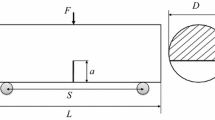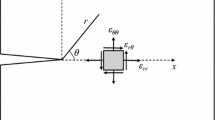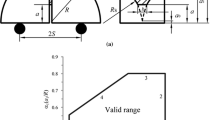Abstract
This paper presents a new procedure for determining the fracture toughness of rock-like specimens using the diametric compression test with the center-cracked horseshoe disk (CCHD) method. Using finite element analysis, a dimensionless stress intensity factor was obtained and a formula was rendered for determining mode I fracture toughness. To evaluate the accuracy of the measurement results produced by the CCHD method, fracture toughness experiments were conducted on the same rock-like material using the notched Brazilian disk (NBD) method. The CCHD tests were simulated using a two-dimensional particle flow code for validation of the experimental results, and a great agreement between the pattern of crack initiation and propagation between the experimental and numerical simulations was observed. Lower values of fracture toughness were obtained from CCHD experiments than NBD tests due to purely tensile stress distribution at the tip of the existing notch in CCHD method.













Similar content being viewed by others
References
Aliha MRM, Ayatollahi MR, Smith DJ, Pavier MJ (2010) Geometry and size effects on fracture trajectory in a limestone rock under mixed mode loading. Eng Fract Mech 77(11):2200–2212
Aliha MRM, Ayatollahi MR, Akbardoost J (2012a) Typical upper bound-lower bound mixed mode fracture resistance envelopes for rock material. Rock Mech Rock Eng 45(1):65–74
Aliha MRM, Sistaninia M, Smith DJ, Pavier MJ, Ayatollahi MR (2012b) Geometry effects and statistical analysis of mode I fracture in guiting limestone. Int J Rock Mech Min Sci 51:128–135
Amrollahi H, Baghbanan A, Hashemolhosseini H (2011) Measuring fracture toughness of crystalline marbles under modes I and II and mixed mode I–II loading conditions using CCNBD and HCCD specimens. Int J Rock Mech Min Sci 48(7):1123–1134
Anderson TL (2005) Fracture mechanics: fundamentals and applica-tions. CRC Taylor & Francis, New York
Atkinson C, Smelser RE, Sanchez J (1982) Combined mode fracture via the cracked Brazilian disk test. Int J Fract 18(4):279–291
Awaji H, Sato S (1978) Combined mode fracture toughness measurement by disk test. J Eng Mater Technol 100(2):175–182
Barton CC (1983) Variables in fracture energy, toughness of Rock. In: Proceedings of the 24th US symposium on rock mechanics. Berkely, pp 449–462
Bergmann G, Vehoff H (1994) Precracking of NiAl single crystals by compression–compression fatigue and its application to fracture-toughness testing. Scr Metall Mater 30(8):969–974
Bobet A, Einstein HH (1998) Fracture coalescence in rock-type materials under uniaxial and biaxial compression. Int J Rock Mech Min Sci 35:863–888
Chang SH, Lee CI, Jeon S (2002) Measurement of rock fracture toughness under modes I and II and mixed-mode conditions by using disc-type specimens. Eng Geol 66(1):79–97
Chen CH, Chen CS, Wu JH (2008) Fracture toughness analysis on cracked ring disks of anisotropic rock. Rock Mech Rock Eng 41(4):539–562
Cui ZD, Liu DA, An GM, Sun B, Zhou M, Cao FQ (2010) A comparison of two ISRM suggested chevron notched specimens for testing mode-I rock fracture toughness. Int J Rock Mech Min Sci 47:871–876
Cundall PA, Strack O (1979) A discrete element model for granular assemblies. Geotechnique 29:47–65
Dai F, Xia K (2013) Laboratory measurements of the rate dependence of the fracture toughness anisotropy of Barre granite. Int J Rock Mech Min Sci 60:57–65
Dai F, Chen R, Iqbal MJ, Xia K (2010a) Dynamic cracked chevron notched Brazilian disc method for measuring rock fracture parameters. Int J Rock Mech Min Sci 47(4):606–613
Dai F, Chen R, Xia K (2010b) A semi-circular bend technique for determining dynamic fracture toughness. Exp Mech 50(6):783–791
Dai F, Xia K, Zheng H, Wang Y (2011) Determination of dynamic rock mode-I fracture parameters using cracked chevron notched semi-circular bend specimen. Eng Fract Mech 78(15):2633–2644
Dai F, Wei MD, Xu NW, Ma Y, Yang DS (2015a) Numerical assessment of the progressive rock fracture mechanism of cracked chevron notched Brazilian disc specimens. Rock Mech Rock Eng 48(2):463–479
Dai F, Wei MD, Xu NW, Zhao T, Xu Y (2015b) Numerical investigation of the progressive fracture mechanisms of four ISRM-suggested specimens for determining the mode I fracture toughness of rocks. Comput Geotech 69:424–441
Dwivedi RD, Soni AK, Goel RK, Dube AK (2000) Fracture toughness of rocks under sub-zero temperature conditions. Int J Rock Mech Min Sci 37:1267–1275
Einstein HH, Baecher GB, Hirschfeld RC (1970) The effect of size on strength in a brittle rock. In: Proceedings of the 2nd International Congress of the International Society for Rock Mechanics, Belgrade, Yugoslavia, September 1970, Theme 3, Vol. 2, pp 3–2
Fowell RJ, Chen JF (1990) The third chevron-notch rock fracture specimen-the cracked chevron-notched Brazilian disk. In: Proceedings 31st US symposium rock. Balkema, Rotterdam, pp 295–302
Fowell RJ, Xu C (1994) The use of the cracked Brazilian disc geometry for rock fracture investigations. Int J Rock Mech Min Sci Geomech Abstr 31(6):571–579
Fowell RJ, Xu C, Dowd PA (2006) An update on the fracture toughness testing methods related to the cracked chevron- notched Brazilian disk (CCNBD) specimen. Pure appl Geophys 163:1047–1057
Gunsallus KL, Kulhawy FH (1984) A comparative evaluation of rock strength measures. Int J Rock Mech Min Sci Geomech Abstr 21(5):233–248
Guo H, Aziz NI, Schmidt LC (1993) Rock fracture toughness determination by the Brazilian test. Eng Geol 33(3):177–188
Haeri H (2015a) Simulating the crack propagation mechanism of pre-cracked concrete specimens under shear loading conditions. Strength of Materials 47(4):618–632
Haeri H (2015b) Influence of the inclined edge notches on the shear-fracture behavior in edge-notched beam specimens. Comput Concrete 16(4):605–623
Haeri H (2016) Propagation mechanism of neighboring cracks in rock-like cylindrical specimens under uniaxial compression. J Min Sci 51(3):487–496
Haeri H, Shahriar K, Fatehi Marji M, Moarefvand P (2013) Modeling the propagation mechanism of two random micro cracks in rock samples under uniform tensile loading, 13th International Conference on Fracture, June 16–21, 2013, Beijing, China
Hedayat A, Walton G (2017) Laboratory determination of rock fracture shear stiffness using seismic wave propagation and digital image correlation. Geotech Test J 40(10):92–106
Hedayat A, Pyrak-Nolte L, Bobet A (2014a) Multi-modal monitoring of slip along frictional discontinuities. Rock Mech Rock Eng 47(5):1575–1587. doi:10.1007/s00603-014-0588-7
Hedayat A, Pyrak-Nolte L, Bobet A (2014b) Detection and quantification of slip along non-uniform frictional discontinuities using digital image correlation. Geotech Test J. doi:10.1520/GTJ20130141
Hedayat A, Pyrak-Nolte L, Bobet A (2014c) Precursors to shear failure of rock discontinuities. Geophys Res Lett 41:5467–5475. doi:10.1002/2014GL060848
Iqbal MJ, Mohanty B (2007) Experimental calibration of ISRM suggested fracture toughness measurement techniques in selected brittle rocks. Rock Mech Rock Eng 40(5):453–475
ISRM (1988) Suggested methods for determining the fracture toughness of rocks, Ouchterlony, F, Coordinator. Int J Rock Mech Min Geomech Abstr 25:73–96
ISRM (2007) The complete ISRM suggested methods for rock characterization, testing and monitoring: 1974–2006. In: Ulusay R, Hudson JA (eds) Suggested methods prepared by the commission on testing methods, International Society for Rock Mechanics, compilation arranged by the ISRM Turkish National Group. Kozan Ofset, Ankara
Itasca PFC2D (1999) Particle Flow Code in 2 Dimensions, Theory and background. Itasca Consulting Group, Minneapolis, pp 1–124
Keles C, Tutluoglu L (2011) Investigation of proper specimen geometry for mode I fracture toughness testing with flattened Brazilian disc method. Int J Fract 169(1):61–75
Kuruppu MD (1998) Stress intensity factors of chevron-notched semi-circular specimens. In: Basu BD et al. (eds) Proceedings 3rd APCOM, the Australasian institute of mining and metallurgy, pp 111–112
Kuruppu MD, Chong KP (2012) Fracture toughness testing of brittle materials using semi-circular bend (SCB) specimen. Eng Fract Mech 91:133–150
Kuruppu MD, Obara Y, Ayatollahi MR, Chong KP, Funatsu T (2014) ISRM-Suggested method for determining the mode I static fracture toughness using semi-circular bend specimen. Rock Mech Rock Eng 47(1):267–274
Lim IL, Johnston IW, Choi SK (1994) Assessment of mixed-mode fracture toughness testing methods for rock. Int J Rock Mech Min Sci Geomech Abstr 31(3):265–272
Mutlu O, Bobet A (2006) Slip propagation along frictional discontinuities. Int J Rock Mech Min Sci 43(6):860–876
Nasseri MHB, Mohanty B, Young RP (2006) Fracture toughness measurements and acoustic emission activity in brittle rocks. Pure appl Geophys 163:917–945
Ouchterlony F (1982) A review of fracture toughness testing of rocks. Solid Mech Arch 7:131–211
Ouchterlony F (1988) ISRM commission on testing methods. Suggested methods for determining fracture toughness of rock. Int J Rock Mech Min Sci Geomech Abstr 25:71–96
Potyondy DO, Cundall PA (2004) A bonded-particle model for rock. Int J Rock Mech Min Sci 41:1329–1364
Potyondy DO, Cundall PA, Lee C (1996) Modeling of rock using bonded assemblies of circular particles. In: Aubertin M (ed) Proceedings of the second north american rock mechanics symposium D NARMS ‘96. Balkema, Rotterdam, pp 1934–1944
Reyes O, Einstein HH (1991) Failure mechanisms of fractured rock – A fracture coalescence model. In: Proceedings of 7th Congress of the ISRM, Aachen, Germany, pp 333–340
Shen B (1995) The mechanism of fracture coalescence in compression-experimental study and numerical simulation. Eng Frac Mech 51:73–85
Shiryaev AM, Kotkis AM (1982) Methods for determining fracture-toughness of brittle porous materials. Ind Lab 48(9):917–918
Suresh S, Ewart L, Maden M, Slaughter WS, Nguyen M (1987) Fracture toughness measurements in ceramics-pre-cracking in cyclic compression. J Mater Sci 22(4):1271–1276
Swan G, Alm O (1982) Sub-critical crack growth in Stripa granite: direct observations. In: Proceedings of the 23rd US symposium on rock mechanics. University of California, Berkeley, pp 542–550
Tang T, Bažant ZP, Yang S, Zollinger D (1996) Variable-notch one-size test method for fracture energy and process zone length. Eng Fract Mech 55(3):383–404
Thiercelin M (1989) Fracture toughness and hydraulic fracturing. Int J Rock Mech Min Sci Geomech Abstr 26:177–183
Thiercelin M, Roegiers JC (1986) Fracture toughness determination with the modified ring test. In: Proceedings of the international symposium on engineering in complex rock formations. Beijing, pp 1–8
Tutluoglu L, Keles C (2011) Mode I fracture toughness determination with straight notched disk bending method. Int J Rock Mech Min Sci 48(8):1248–1261
Tutluoglu L, Keles C (2012) Effects of geometric factors on mode I fracture toughness for modified ring tests. Int J Rock Mech Min Sci 51:149–161
Wang QZ, Xing L (1999) Determination of fracture toughness KIc by using the flattened Brazilian disc specimen for rocks. Eng Fract Mech 64(2):193–201
Wang QZ, Jia XM, Kou SQ, Zhang ZX, Lindqvist PA (2003) More accurate stress intensity factor derived by finite element analysis for the ISRM suggested rock fracture toughness specimen-CCNBD. Int J Rock Mech Min Sci 4(2):233–241
Wawrzynek PA, Ingraffea AR (1991) Discrete modelling of crack propagation: theoretical aspects and implementation issues in two and three dimensions. In: Report 91-5, school of civil and environmental engineering. Cornell Univ., Ithaca
Wei MD, Dai F, Xu NW, Xu Y, Xia K (2015) Three-dimensional numerical evaluation of the progressive fracture mechanism of cracked chevron notched semi-circular bend rock specimens. Eng Fract Mech 134:286–303
Xu NW, Dai F, Wei MD, Xu Y, Zhao T (2015) Numerical observation of three dimensional wing-cracking of cracked chevron notched Brazilian disc rock specimen subjected to mixed mode loading. Rock Mech Rock Eng. doi:10.1007/s00603-015-0736-8
Yang S, Tang TX, Zollinger D, Gurjar A (1997) Splitting tension tests to determine rock fracture parameters by peak-load method. Adv Cem Based Mater 5:18–28
Zhou YX, Xia K, Li XB, Li HB, Ma GW, Zhao J, Zhou ZL, Dai F (2012) Suggested methods for determining the dynamic strength parameters and mode-I fracture toughness of rock materials. Int J Rock Mech Min Sci 49:105–112
Author information
Authors and Affiliations
Corresponding author
Rights and permissions
About this article
Cite this article
Haeri, H., Sarfarazi, V., Yazdani, M. et al. Experimental and Numerical Investigation of the Center-Cracked Horseshoe Disk Method for Determining the Mode I Fracture Toughness of Rock-Like Material. Rock Mech Rock Eng 51, 173–185 (2018). https://doi.org/10.1007/s00603-017-1310-3
Received:
Accepted:
Published:
Issue Date:
DOI: https://doi.org/10.1007/s00603-017-1310-3




